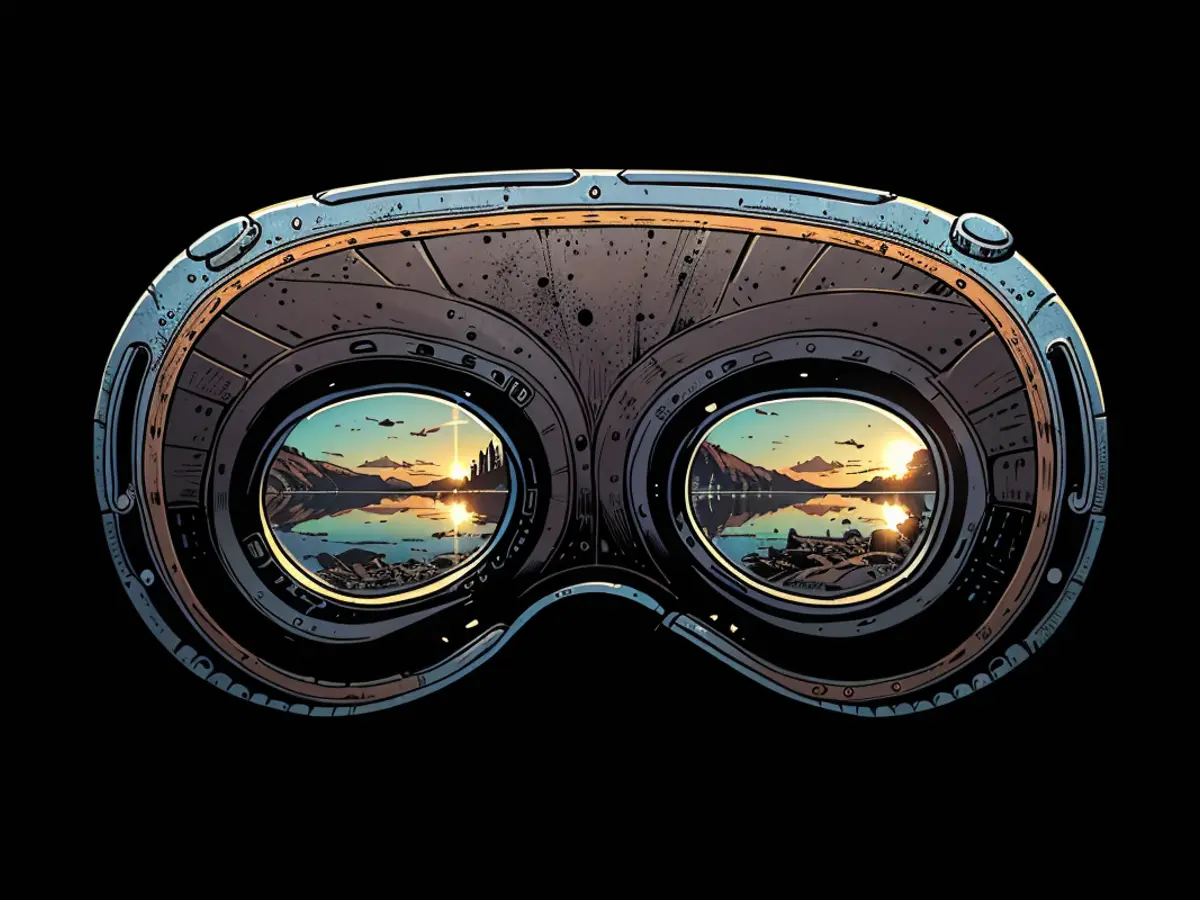The Apple Vision Pro is an impressive ego trip
Product Niche or the Next Big Thing? Apple Vision Pro is now available in Germany. In the test, the nearly 4000 Euro priced Computer-Glasses from Apple show strengths in entertainment and provide glimpses into a possible AR future.
It took a long time, but it's finally here: Apple's entry into extended reality, affectionately called "spatial computing" by the iPhone maker. The high-tech glasses named Vision Pro aim to bring digital content into real environments and establish a new computer platform. What can this device costing around 4000 Euro, now available in Germany, offer?
Fundamentally a VR Glasses
From the outside, the Vision Pro looks a bit like a ski goggle with an aluminum frame. The front part is filled with a display. It can, indeed, shield the eye area of the person wearing the headset. The battery is housed in a luxury version of an external battery with an aluminum shell. This saves weight on the head and helps make the Vision Pro more wearable for extended periods.
For the fit, the face - similar to setting up Face ID facial recognition - is scanned. This selects the correct light seal, which then shields the field of view from external light.
Technically speaking, one could call the Vision Pro a VR headset: Like other devices for displaying virtual reality, it has displays instead of transparent lenses in front of the eyes. However, the Vision Pro is designed specifically to blend digital objects into the real environment. So: Extended Reality (AR), but also the possibility of VR.
Once put on and turned on, you see the room you're in - and app symbols float in the air at a certain distance in front of you. For this, the Vision Pro has several cameras that capture the environment, recognize movements, and detect the position of arms, hands, and fingers. The image is then projected onto the displays in front of your eyes. Each display has more pixels than a 4K TV. Therefore, the image is completely clear, without the "screen door" effect, which is known from some other headsets.
Spinning the Wheel

At the same time, you can also transport yourself somewhere else - for example, to a lake or the moon. This happens seamlessly by rotating the digital crown, similar to the one on the Apple Watch or the AirPods Max headphones. The real environment is then gradually replaced by the virtual image. If other people are in the room and speak to you, they are integrated into the artificial environment, a bit like a ghost.
Pressing the crown summons the app symbols. The crown is located on the right side of the glasses, and there is also a second button on the left side. You press it, for example, twice when buying an app. Similar to facial recognition Face ID or the fingerprint sensor, there is also biometric identification on the Vision Pro. Optic ID recognizes the person based on the iris pattern. This works more smoothly and error-free than Face ID on the iPhone.
There is a speaker at each ear that can reproduce 3D audio. The direction of the sound source adjusts itself exactly and without delay based on the position of the source.
Looking instead of clicking
For operating the Vision Pro, you mainly need to learn one gesture. Pressing the thumb and index finger together has the effect of a mouse click. The role of the cursor is taken over by the gaze: What you look at is also clicked.
A virtual keyboard appears, and one can directly press the letter keys on it using their own fingers. Visual effects help identify if a button has been pressed: The buttons seem to yield slightly, as if one is pressing on a tightly stretched film. Although the fingers only touch air, the brain perceives a haptic feedback of sorts.
Cinema Experience in Giant Format with Pantoffel-Kino

One of the superpowers of the Vision Pro is the ability to float large displays in space. This allows one to watch videos in giant format with a cinema experience. While YouTube and Netflix are currently only available through the web browser, Disney+ has an app for the Vision Pro, allowing for 3D movies to be viewed.
In the Apple TV app, there is also a demo "immersive" videos, which are more realistic than the 3D effects known from the cinema. There are elephants at the watering hole, parkour runners in Paris, and a woman on a slackline between cliffs. Above all, however, sports - American Football, soccer, basketball - are experienced from the midst of the action like never before.
iPhone 15 Pro as a 3D Camera
Apple takes videos with special cameras developed in-house. However, the iPhone 15 Pro also takes immersive videos that can be played back on the Vision Pro. They remind one of memories from the Memory Cabinet in Harry Potter films: realistic 3D image with a slight haze around the edges. It may be a unique way to relive valuable memories such as a child's first birthday or exceptional vacation experiences.
With regular images and videos, one has the advantage of viewing them in giant format in the Vision Pro. And for those who have collected Panorama shots with the iPhone over the years, they can finally benefit from it: They can be unfurled into 360-degree views on the movie screen. With apps like "Luminar," one can even edit images in the Vision Pro.
Working Capabilities
The ability of the Vision Pro to fill the room with displays also pays off when working. The windows for email, messages, and other apps can be arranged next to each other and resized. Apple's Bluetooth keyboard and trackpad can be directly paired with the Vision Pro and used for typing and control. Since the headset reproduces the environment, the devices can lie on the desk, and one can see them thanks to the built-in cameras in the glasses.

One can also connect a Mac computer to the Vision Pro, which then takes on the role of the display - with much more screen space and high resolution. The clou: The keyboard and trackpad of the MacBook function seamlessly for both the programs on the computer and those running directly on the computer glasses. For all office workers who wish for more screen space, this works exceptionally well.
For computer design applications, working with 3D objects is possible, which can be edited and transferred from app to app in giant format. The fashion house Gucci demonstrated how this can be used for a new storytelling format: A video for the presentation of the new chief designer Sabato de Sarno is accompanied by 3D objects from the new collection and other special effects in the Vision Pro.
Video Telephony in Persona
With video telephony in the Vision Pro, one can make calls as if one were actually there. The other person appears life-size and in three dimensions, making communication more personal and engaging. The environment around the caller is also displayed, allowing for a more immersive experience. This not only makes video calls more enjoyable but also opens up new possibilities for remote collaboration and virtual meetings.
For Video telephony in the Vision Pro by Apple, there is also a 3D function. For this, one holds the headset in front of the face and needs to move the head in different directions. The result is a kind of hologram that then comes into use during the call. Due to the cameras at the bottom of the Vision Pro, this "Persona" Avatar follows in real-time the own mimic. The 3D holograms of conversation partners can appear both in the window and freely in the real environment - even with hands.
For gaming, the Vision Pro relies heavily on Apple's in-house subscription platform Arcade. At the German launch, there are titles like "Warped Kart Racers," where you steer animated racing cars with the movements of an imaginary steering wheel, and "Super Fruit Ninja," where it's about slicing virtual fruit with a wave of the hand.
Brill wearers pay more

For 3999 Euro, one gets the version with 256 Gigabyte storage. For 512 GB, the price increases to 4249 Euro, and the top model with a terabyte storage place costs 4499 Euro in Germany. For Brill wearers, there is no additional stand holder, but individually adjusted Zeiss lenses instead. These cost up to 169 Euro.
With the next version of the operating system visionOS, the Apple Glass will receive new functions from the fall. For example, software will convert regular images from the media library into spatial photos. With new gestures, one can set the volume and call up the home view. The virtual Mac display can be expanded into a curved screen the size of two adjacent 4K monitors.
Guest mode and travel mode
A guest mode will save their eye settings, so that the Vision Pro does not have to be recalibrated for them every time. The travel mode, which until now only existed for aircraft use, will be expanded for use in trains.
Apple not uncontested
Apple enters a field that Facebook's Meta Corporation has been exploring for years. Mark Zuckerberg speaks of the "Metaverse" as a virtual world for work and entertainment. His counterpart is Meta Quest 3 from Facebook, which costs from 549.99 Euro and also embeds digital content into real environments. HTC offers solutions where teams can interact, such as the Vive XR Elite for 1399 Euro.
Apple benefits in comparison, among other things, from the higher resolution of the displays in front of the eyes and the fact that the Vision Pro can work with other devices from the company like MacBooks. HTC, on the other hand, offers solutions where teams can interact. For example, the police and the Bundeswehr use the Taiwanese VR Glass for training missions.

Conclusion
Apple establishes a new computer platform with the Vision Pro. Due to the high display resolution and the integration with other devices from the company, it offers significantly more than previous VR glasses. The possibility of using large virtual monitors for office applications and spatial videos for private memories is a game changer.
Hardcore gamers, however, may still be better served by Virtual Reality from the PC like the Index from Valve. A price of nearly 4000 Euro for the Vision Pro is a high entry price to experience this technology revolution up close. But everyone who is interested should try the Vision Pro in an Apple Store.
The Vision Pro from Apple, with its VR-like display capabilities, aims to blend digital content into real environments, making it an extended reality device. Its high-resolution displays and integration with other Apple devices set it apart from competitors in the market.
Although the Vision Pro can transport you to virtual environments with its 3D audio capabilities and seamless environment switching, its true strength lies in its ability to display large virtual monitors for office applications and immersive 3D videos for private memories.








